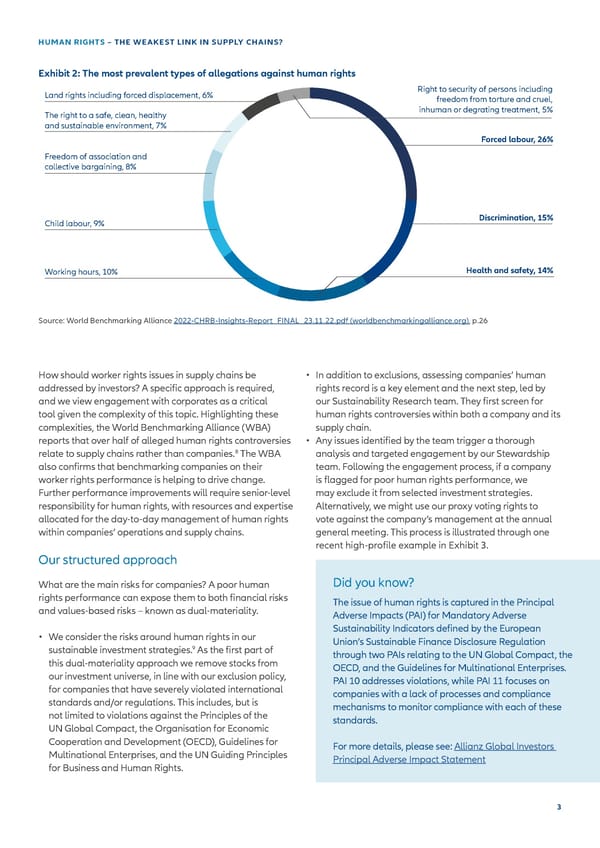HUMAN RIGHTS – THE WEAKEST LINK IN SUPPLY CHAINS? Exhibit 2: The most prevalent types of allegations against human rights Land rights including forced displacement, 6% Right to security of persons including freedom from torture and cruel, The right to a safe, clean, healthy inhuman or degrating treatment, 5% and sustainable environment, 7% Forced labour, 26% Freedom of association and collective bargaining, 8% Child labour, 9% Discrimination, 15% Working hours, 10% Health and safety, 14% Source: World Benchmarking Alliance 2022-CHRB-Insights-Report_FINAL_23.11.22.pdf (worldbenchmarkingalliance.org), p.26 How should worker rights issues in supply chains be • In addition to exclusions, assessing companies’ human addressed by investors? A speci昀椀c approach is required, rights record is a key element and the next step, led by and we view engagement with corporates as a critical our Sustainability Research team. They 昀椀rst screen for tool given the complexity of this topic. Highlighting these human rights controversies within both a company and its complexities, the World Benchmarking Alliance (WBA) supply chain. reports that over half of alleged human rights controversies • Any issues identi昀椀ed by the team trigger a thorough 8 relate to supply chains rather than companies. The WBA analysis and targeted engagement by our Stewardship also con昀椀rms that benchmarking companies on their team. Following the engagement process, if a company worker rights performance is helping to drive change. is 昀氀agged for poor human rights performance, we Further performance improvements will require senior-level may exclude it from selected investment strategies. responsibility for human rights, with resources and expertise Alternatively, we might use our proxy voting rights to allocated for the day-to-day management of human rights vote against the company’s management at the annual within companies’ operations and supply chains. general meeting. This process is illustrated through one recent high-pro昀椀le example in Exhibit 3. Our structured approach What are the main risks for companies? A poor human Did you know? rights performance can expose them to both 昀椀nancial risks The issue of human rights is captured in the Principal and values-based risks – known as dual-materiality. Adverse Impacts (PAI) for Mandatory Adverse • We consider the risks around human rights in our Sustainability Indicators de昀椀ned by the European Union’s Sustainable Finance Disclosure Regulation 9 sustainable investment strategies. As the 昀椀rst part of through two PAIs relating to the UN Global Compact, the this dual-materiality approach we remove stocks from OECD, and the Guidelines for Multinational Enterprises. our investment universe, in line with our exclusion policy, PAI 10 addresses violations, while PAI 11 focuses on for companies that have severely violated international companies with a lack of processes and compliance standards and/or regulations. This includes, but is mechanisms to monitor compliance with each of these not limited to violations against the Principles of the standards. UN Global Compact, the Organisation for Economic Cooperation and Development (OECD), Guidelines for For more details, please see: Allianz Global Investors Multinational Enterprises, and the UN Guiding Principles Principal Adverse Impact Statement for Business and Human Rights. 3
 Human rights Page 2 Page 4
Human rights Page 2 Page 4